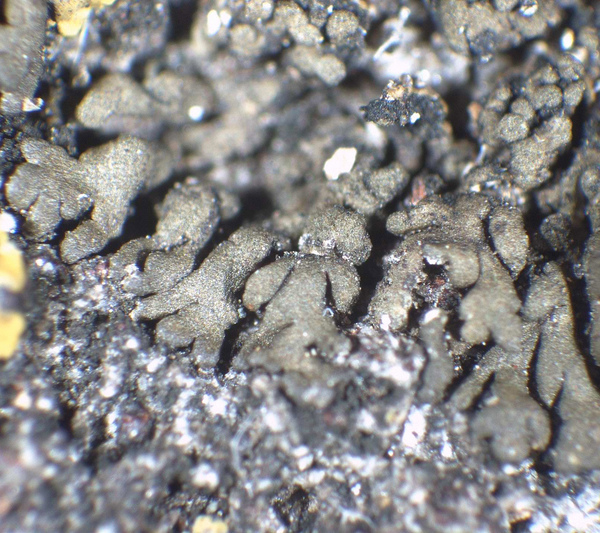Peltula placodizans (Zahlbr.) Wetmore
Ann. Missouri Bot. Gard., 57: 196, 1970. Basionym: Heppia placodizans Zahlbr. - Bull. Torrey Bot. Cl., 35: 299, 1908.
Synonyms: Endocarpiscum placodizans (Zahlbr.) Fink
Distribution: N - TAA. C - Sar.
Description: Thallus crustose-placodioid to subsquamulose, areolate in central parts, lobed at margins, the central areoles rounded, flat or convex, 0.1-0.5 mm wide, with blackish, laminal, capitate soralia bearing farinose soredia; marginal lobes simple to sparingly branched, up to 1.3 mm long, 0.2-0.5 mm wide, brownish to olive-green; lower surface paler than upper surface. Upper cortex not developed, but upper surface with a yellowish epinecral layer; medulla of loosely interwoven hyphae with globose cells and numerous air spaces; lower cortex poorly developed, paraplectenchymatous, with globose cells. Apothecia very rare, 0.1-0.3 mm across, usually 1 per squamule, immersed, with a punctiform, yellowish brown to blackish brown disc and a poorly evident thalline margin. Epithecium yellowish brown, K+ red-violet or K-; hymenium colourless, I+ wine-red, 90-120 µm; hypothecium colourless. Asci >64-spored, clavate to obclavate, rostrate, the wall I+ orange, K/I+ blue. Ascospores 1-celled, globose to ellipsoid, (3-)4.5-8 x 3-5 µm. Pycnidia immersed, cerebriform. Conidia fusiform, c. 3.5 x 1.5 µm. Photobiont cyanobacterial, chroococcoid. Spot tests: thallus and medulla K-, C-, KC-, P-, UV-. Chemistry: without lichen substances.Note: on steeply inclined seepage tracks of basic siliceous rocks, both in the Mediterranean belt and in warm-dry Alpine valleys.
Growth form: Crustose placodiomorph
Substrata: rocks
Photobiont: cyanobacteria, filamentous (e.g. Nostoc, Scytonema)
Reproductive strategy: mainly sexual
On otherwise dry surfaces with short periods of water seepage after rain
Commonnes-rarity: (info)
Alpine belt: absent
Subalpine belt: absent
Oromediterranean belt: absent
Montane belt: absent
Submediterranean belt: extremely rare
Padanian area: absent
Humid submediterranean belt: absent
Humid mediterranean belt: absent
Dry mediterranean belt: very rare
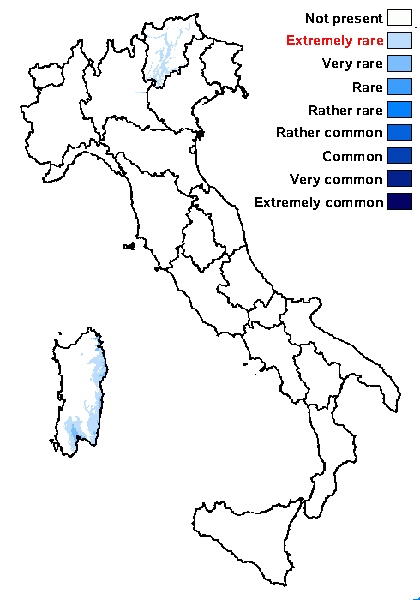
Predictive model
Herbarium samples
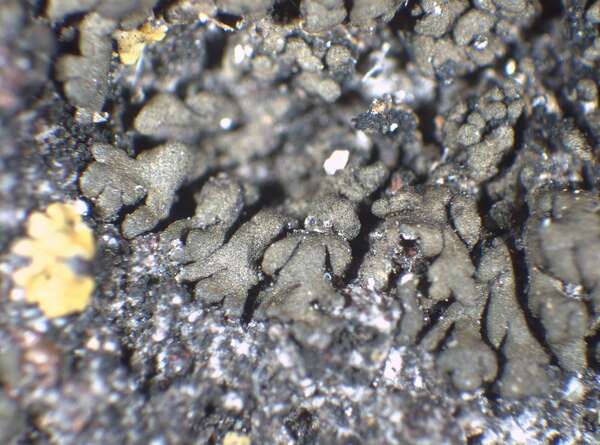

P.L. Nimis; Owner: Department of Life Sciences, University of Trieste
Herbarium: TSB (17553)
2003/03/12


Felix Schumm - CC BY-SA 4.0
[ABL48040], Brazil, Sergipe, Poço Redondo, Cajueiros, Trilha Ecoparque.
09°39'43'' S, 45°40'18'' W, 30 m. On siliceous rock in Caatinga.
Leg. M. Cáceres & A. Aptroot, (no. 48040), 15. November 2018, det.
A. Aptroot 2018.
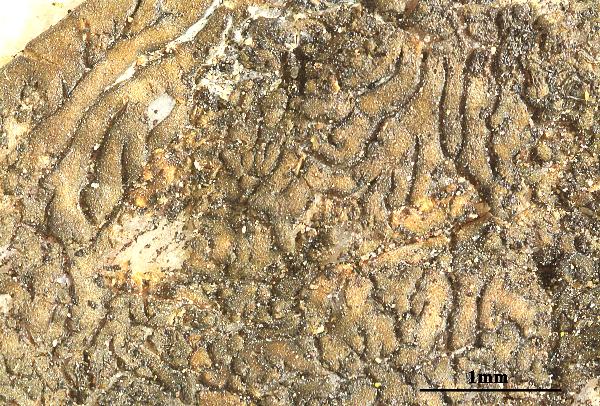

Felix Schumm - CC BY-SA 4.0
[ABL48040], Brazil, Sergipe, Poço Redondo, Cajueiros, Trilha Ecoparque.
09°39'43'' S, 45°40'18'' W, 30 m. On siliceous rock in Caatinga.
Leg. M. Cáceres & A. Aptroot, (no. 48040), 15. November 2018, det.
A. Aptroot 2018.
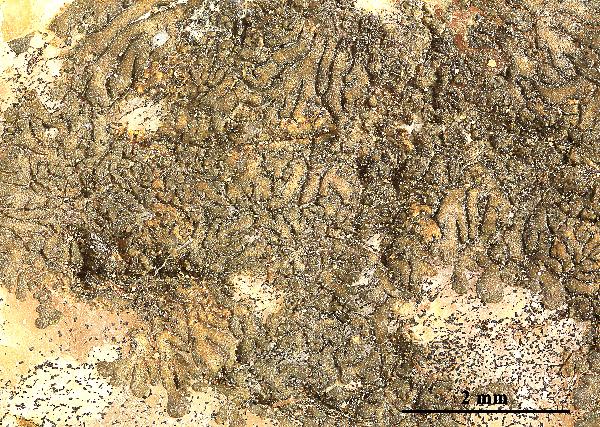

Felix Schumm - CC BY-SA 4.0
[ABL48040], Brazil, Sergipe, Poço Redondo, Cajueiros, Trilha Ecoparque.
09°39'43'' S, 45°40'18'' W, 30 m. On siliceous rock in Caatinga.
Leg. M. Cáceres & A. Aptroot, (no. 48040), 15. November 2018, det.
A. Aptroot 2018.
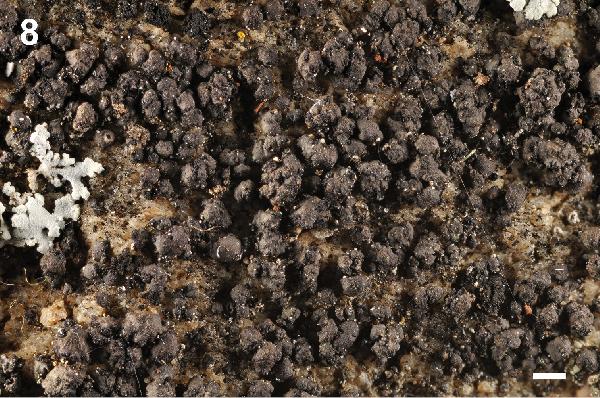
Source: Westberg M, Timdal E, Asplund J, Bendiksby M, Haugan R, Jonsson F, Larsson P, Odelvik G, Wedin M, Millanes AM (2015) New records of lichenized and lichenicolous fungi in Scandinavia. MycoKeys 11: 33-61. - CC BY-4.0
NORWAY. Oppland: Sør-Fron municipality, Harpefoss, along the trail W of farm Tåkåstad towards Mt. Lundin, 61°34.95'N, 9°52.55'E, alt. 490 m. 1 Oct. 2007, Timdal 11054 (O L-158470), TLC: no lichen substances.
Scale: 1 mm
Growth form: Crustose placodiomorph
Substrata: rocks
Photobiont: cyanobacteria, filamentous (e.g. Nostoc, Scytonema)
Reproductive strategy: mainly sexual
On otherwise dry surfaces with short periods of water seepage after rain
Commonnes-rarity: (info)
Alpine belt: absent
Subalpine belt: absent
Oromediterranean belt: absent
Montane belt: absent
Submediterranean belt: extremely rare
Padanian area: absent
Humid submediterranean belt: absent
Humid mediterranean belt: absent
Dry mediterranean belt: very rare

Predictive model
| Herbarium samples |


P.L. Nimis; Owner: Department of Life Sciences, University of Trieste
Herbarium: TSB (17553)
2003/03/12


Felix Schumm - CC BY-SA 4.0
[ABL48040], Brazil, Sergipe, Poço Redondo, Cajueiros, Trilha Ecoparque. 09°39'43'' S, 45°40'18'' W, 30 m. On siliceous rock in Caatinga. Leg. M. Cáceres & A. Aptroot, (no. 48040), 15. November 2018, det. A. Aptroot 2018.


Felix Schumm - CC BY-SA 4.0
[ABL48040], Brazil, Sergipe, Poço Redondo, Cajueiros, Trilha Ecoparque. 09°39'43'' S, 45°40'18'' W, 30 m. On siliceous rock in Caatinga. Leg. M. Cáceres & A. Aptroot, (no. 48040), 15. November 2018, det. A. Aptroot 2018.


Felix Schumm - CC BY-SA 4.0
[ABL48040], Brazil, Sergipe, Poço Redondo, Cajueiros, Trilha Ecoparque. 09°39'43'' S, 45°40'18'' W, 30 m. On siliceous rock in Caatinga. Leg. M. Cáceres & A. Aptroot, (no. 48040), 15. November 2018, det. A. Aptroot 2018.

 INDEX FUNGORUM
INDEX FUNGORUM
 GBIF
GBIF
 DOLICHENS
DOLICHENS
